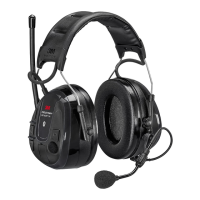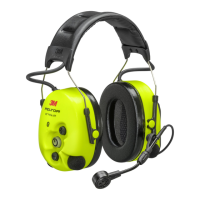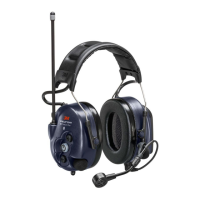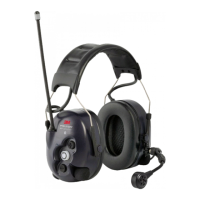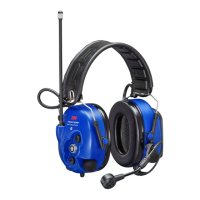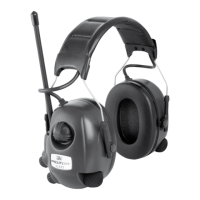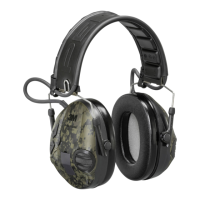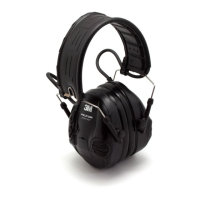4
Table ref. Description
C:3 Criterion input signal (dBFS) for which the
sound output level is equal to 82 dB(A)
C:4 Sound output level for maximum input signal
(dB(A))
C:5 Time equivalent to 82 dB(A) over 8h (hh:mm)
for maximum input signal
4.3. STANDARDS ANSI S3.19-1974 (US) AND
CSA 22.2 (CANADA)
U.S. EPA species the NRR as the measure of hearing
protector noise reduction. However, 3M makes no warranties
as to the suitability of the NRR for this purpose. 3M strongly
recommends personal t testing of hearing protectors.
Research suggests that users may receive less noise reduction
than indicated by the attenuation label value(s) on the
packaging due to variation in t, tting skill, and motivation of
the user. Refer to applicable regulations and guidance on how
to adjust attenuation label value(s). It is recommended that the
NRR be reduced by 50% to better estimate typical protection.
Table ref. Description
E:A Headband earmuffs with foam cushions
E:B Carrier attachment earmuffs with foam
cushions
E:1 Frequency (Hz)
E:2 Mean Attenuation (dB)
E:3 Standard Deviation (dB)
E:4 NRR = Noise Reduction Rating
E:5 CSA Class (CSA = Canadian Standard
Association)
4.4. STANDARD AS/NZS 1270:2002
Table ref. Description
F:A Headband earmuffs with foam cushions /
Headband earmuffs with gel cushions
F:B Carrier attachment earmuffs with foam
cushions / Carrier attachment earmuffs with
gel cushions
F:1 f = Frequency (Hz)
F:2 M
f
= Mean Attenuation (dB)
F:3 SD
f
= Standard Deviation (dB)
F:4 M
f
- SD
f
= Mean minus SD
F:5 SLC
80
= Sound Level Conversion rating
F:6 Class
F:7 Clamping force (N)
4.5. CARRIER DEVICES
These earmuffs should be tted to and used only with the
carrier devices listed in Table D. These earmuffs were tested
in combination with the carrier devices listed in Table D, and
may give different levels of protection if tted to different
carrier devices.
Explanation of the carrier attachment table:
Table ref. Description
D:A Compatible carrier devices
D:B
Carrier attachment earmuffs with foam
cushions
D:C
Carrier attachment earmuffs with gel
cushions
D:1 Manufacturer
D:2 Model
D:3 Attachment code
D:4 Head size: S = small, M = medium, L = large
When selecting accessories to respiratory personal protective
equipment, such as carrier mounted hearing protection,
please consult the NIOSH approval label or consult 3M
Technical Services for approved congurations.
5. OVERVIEW
5.1. G) COMPONENTS
(Figure G)
G:1 Headband (PVC, PA)
G:2 Headband wire (stainless steel)
G:3 Two-point fastener (POM)
G:4 Cushion (PVC foil and PUR foam)
G:5 Foam liner (PUR foam)
G:6 Cup (ABS)
G:7 Level-dependent microphone for ambient listening
(PUR foam)
G:8 Speech microphone (ABS, PA)
G:9 Wind shield (PUR foam)
6. SETUP
6.1. GENERAL
The following points cover the main actions to make the
product ready for operation.
6.2. REMOVE/INSTALL BATTERIES
Make sure you have read and understood the contents of
Chapter 2. Safety before replacing the battery/batteries.
(Figure 1)
1. Detach the latch on the left cup with your ngers.
EN
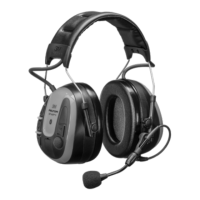
